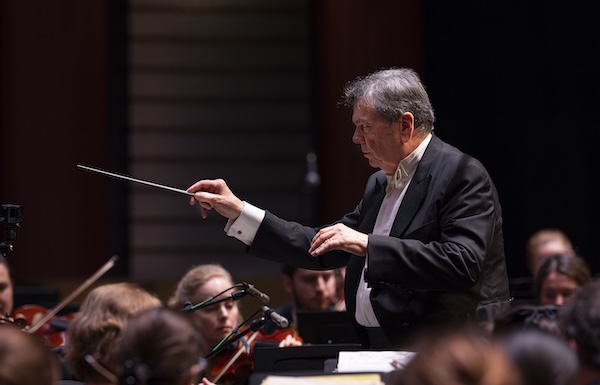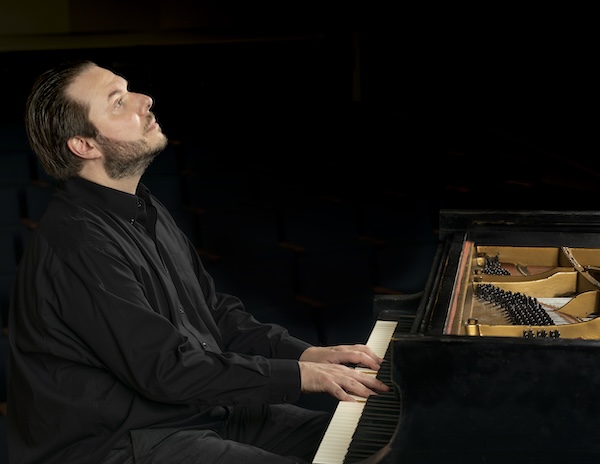Palm Beach Symphony closes season with a feast of Beethoven

Gerard Schwarz conducted the Palm Beach Symphony’s final concert of the season Thursday night at the Kravis Center. File photo: IndieHouse Films
The Palm Beach Symphony ended its 50th season Thursday night with an all-Beethoven concert that began with the composer’s first major orchestral work and ended with his last.
The concert opened with a piano concerto composed largely for Beethoven’s own use as soloist and concluded with the Symphony No. 9, a work that would tower over the next century of music, inspiring such composers as Brahms, Wagner, Bruckner and Mahler.
Anyone not fond of all-Beethoven programs, by the way, may have a rough time in a couple of years with the 2027 concert season, which will take place on the 200th anniversary of Beethoven’s death—and following the composer’s 250th birthday anniversary in 2020.
Although published after Beethoven’s first keyboard concerto, the Piano Concerto No. 2 was actually composed earlier, begun in 1787 while Mozart was still alive. Beethoven would revise it for years.
Handling the solo part was Ignat Solzhenitsyn, the Russian-American pianist and son of the celebrated author and critic of Soviet communism Aleksandr Solzhenitsyn.

Ignat Solzhenitsyn performed Beethoven’s Piano Concerto No. 2 with the Palm Beach Symphony Thursday night. Photo: Steve Riskind
To say that a performance was Classical in proportions can imply that it was dry and metronomic. But without pounding the keyboard or going much above forte, Solzhenitsyn gave a sparkling, buoyant account of the work’s busy and melodic solo part. His tone was singing and rounded in the lyric passages that looked forward to Romantic piano concertos. The cadenza came off as virtuosic, rumbling and grandiose.
Accompanying him was an orchestra reduced in size to accommodate the concerto’s 18th-century proportions, conducted by music director Gerard Schwarz. Although there were intonation issues in the violins, the orchestra provided sturdy support.
In the Adagio, Solzhenitsyn’s playing was noble and unhurried in the lofty solo line. The orchestra provided a luminous account of its dark-hued passages. In the concluding Rondo, he gave an energetic account, with strongly marked rhythms and dramatic syncopations.
As an encore, Solzhenitsyn played Beethoven’s Presto in C Minor Op. 52, also known as the Bagatelle in C Minor. In this work, based on a motif that resembled the opening of Beethoven’s forthcoming Fifth Symphony, Solzhenitsyn offered an assertive, highly articulated performance that grew in force and power as the music became more complex.
The second half was devoted to Beethoven’s Symphony No. 9, providing an uplifting and celebratory finale to a successful season by an orchestra that seems to get better every year.
From the tense, brooding opening, the orchestra played with tight precision. Schwarz led a middle-of-the-road performance that seemed to emphasize clarity and accuracy. Although this underplayed some of the work’s dramatic contrasts, such as the aggressive passages of the first movement and the jagged, dissonant opening of the Finale, it allowed the work’s abundant drama to come through without forcing it.
The precision paid off in the Scherzo, which seemed particularly grim and full of nervous energy. Out-of-tune playing marred some of the long melodic lines of the Adagio, but the movement still came off with sweeping lyric ardor, an interval of tranquility between the tension of the Scherzo and the drama of the Finale.
Waiting patiently behind the orchestra for three movements was a large chorus from the University of Miami’s Frost School of Music that included the Frost Chorale, Frost Bella Voce, Frost Symphonic Choir and Frost Chamber Singers, under the direction of Amanda Quist, the school’s director of choral studies.
To begin the vocal drama, after the orchestra tries out various themes from the preceding movements, bass-baritone Keith Klein rose and sang, “O Freunde, nicht diese Töne.” He brought a dramatic verve to the vocal line, in which a single voice stands out heroically against the orchestra.
Aside from Klein, the quartet of vocal soloists consisted of soprano Hayley Lipke, mezzo-soprano Robynne Redmon and tenor Joseph McBrayer, all of whom did well in their solo parts.
Lipke’s voice soared above the other three in Beethoven’s treacherously high soprano writing. McBrayer gave a lively and tonally rich performance of his solo during the military clanking of spurs and swords of the Turkish March.
In the chorus, male voices gave a stark and precise account of a solo passage that sounded like the intrusion of a Medieval chant into a 19th century symphony. The massed chorus gave a jubilant, vivacious performance of the famous “Ode to Joy” theme, with a dynamic flexibility that brought the music down to a smoldering quiet before rising in a swift crescendo to full volume.
The Palm Beach Symphony has announced its 2024-25 season, which will include another stellar group of soloists. Among them will be violinists Leonidas Kavakos and Gil Shaham, cellist Julian Schwarz, and pianists Jean Yves-Thibaudet, Garrick Ohlsson and Anne-Marie McDermott. The concerts will include a generous number of works by American composers, including Ellen Taaffe Zwilich, Christopher Theofanidis, Jennifer Higdon, Paul Creston and William Grant Still. palmbeachsymphony.org
Posted in Performances
Leave a Comment
Fri Apr 26, 2024
at 1:52 pm
No Comments